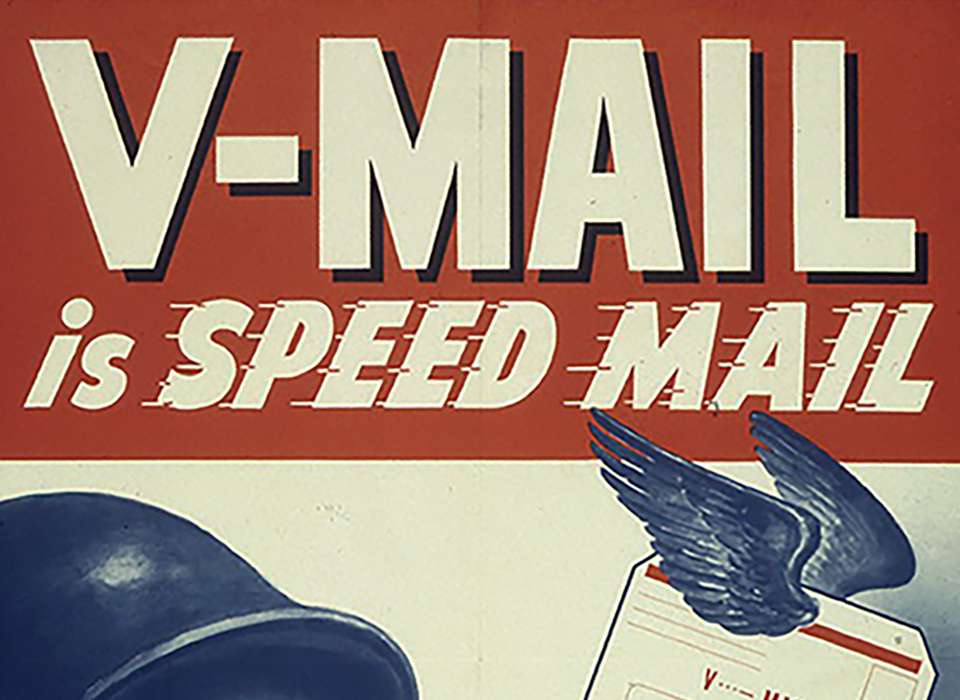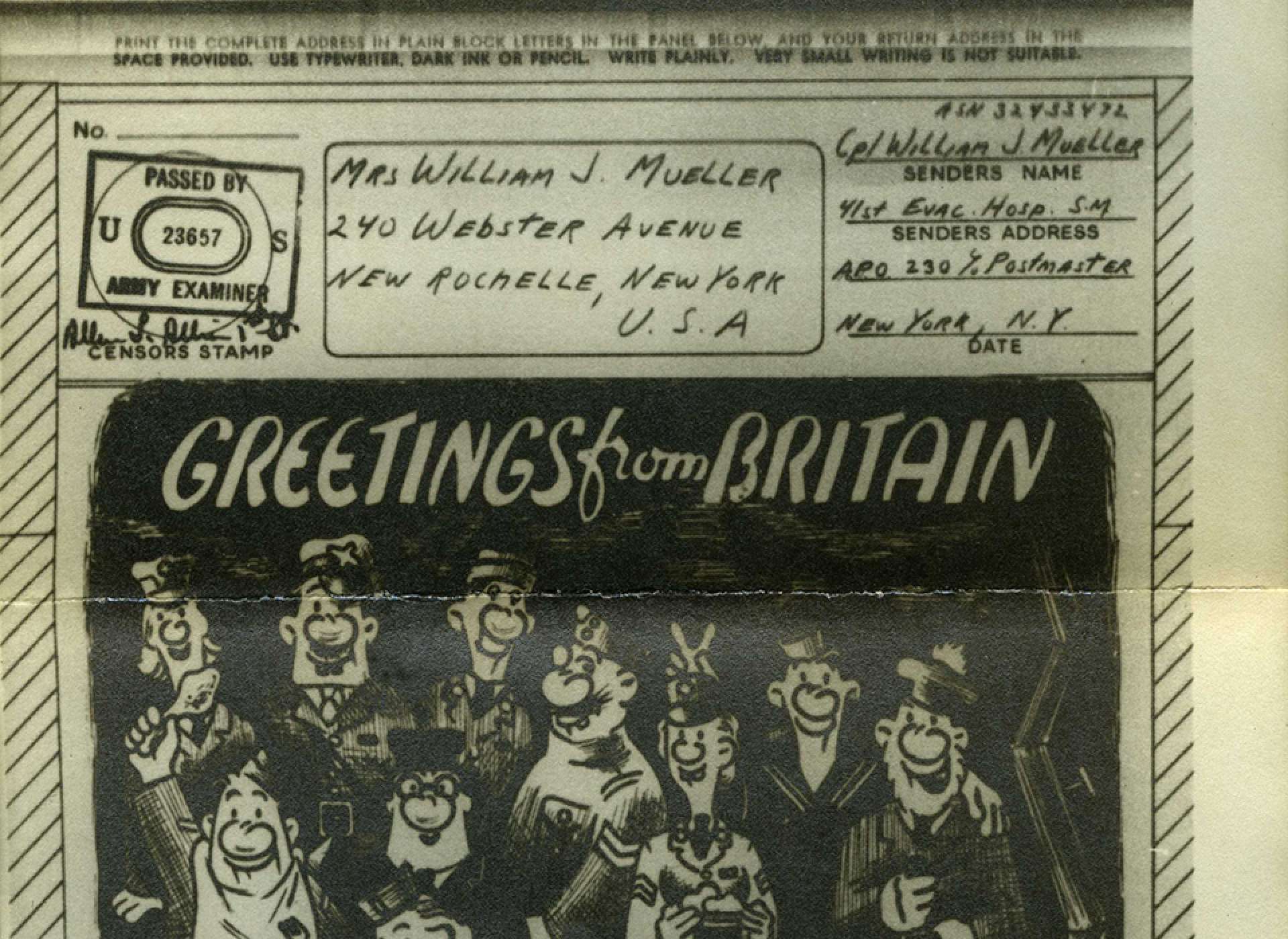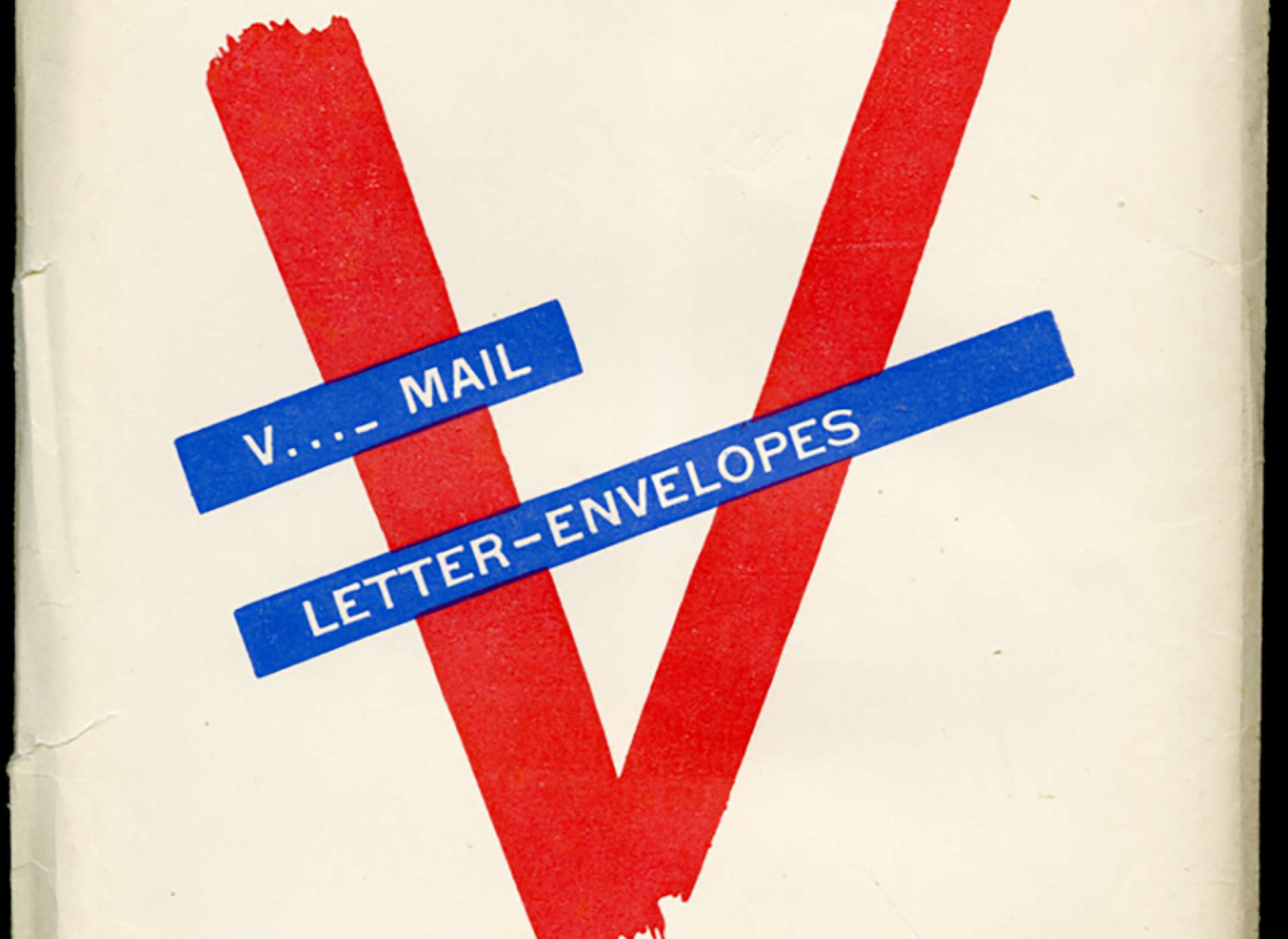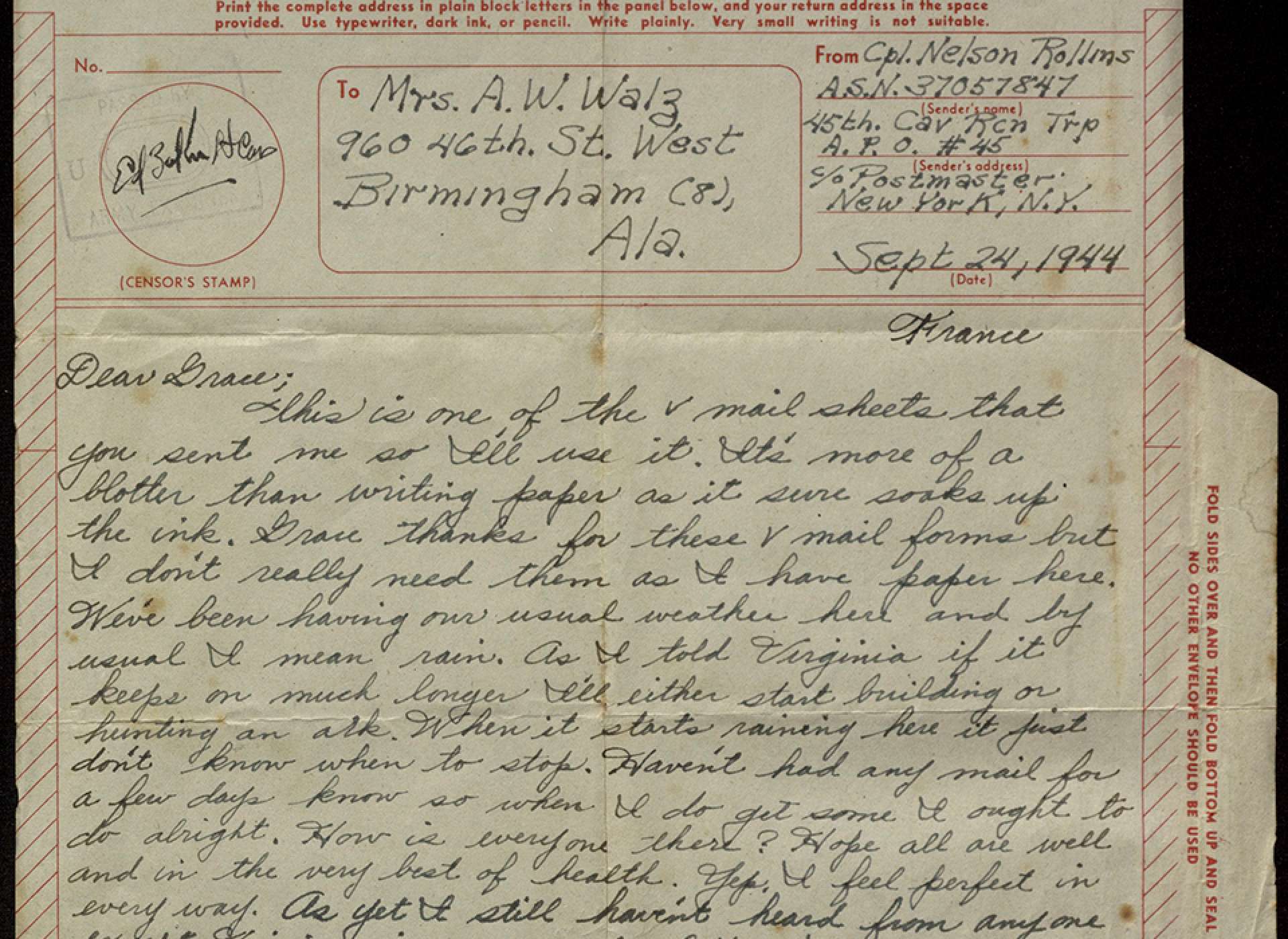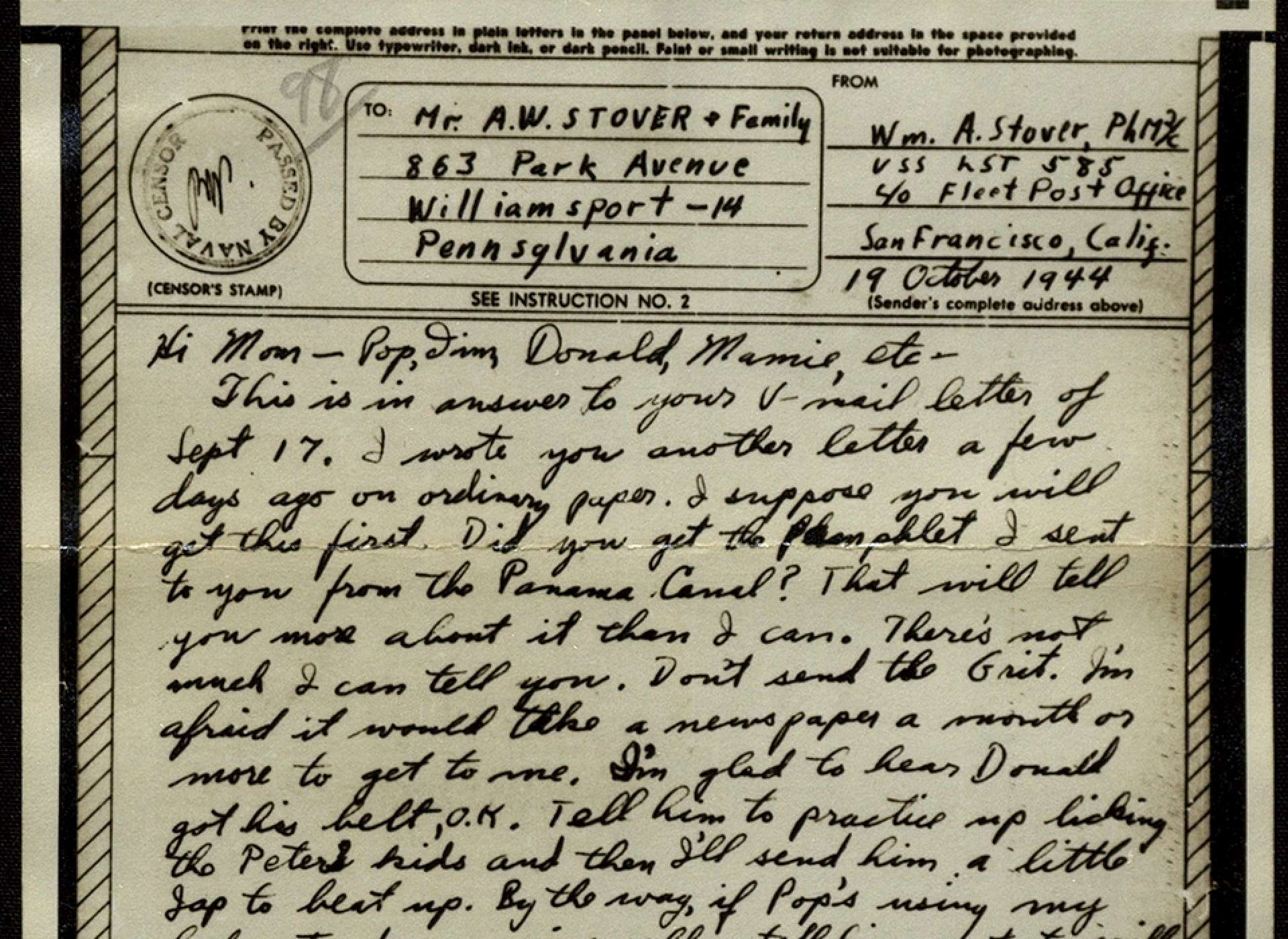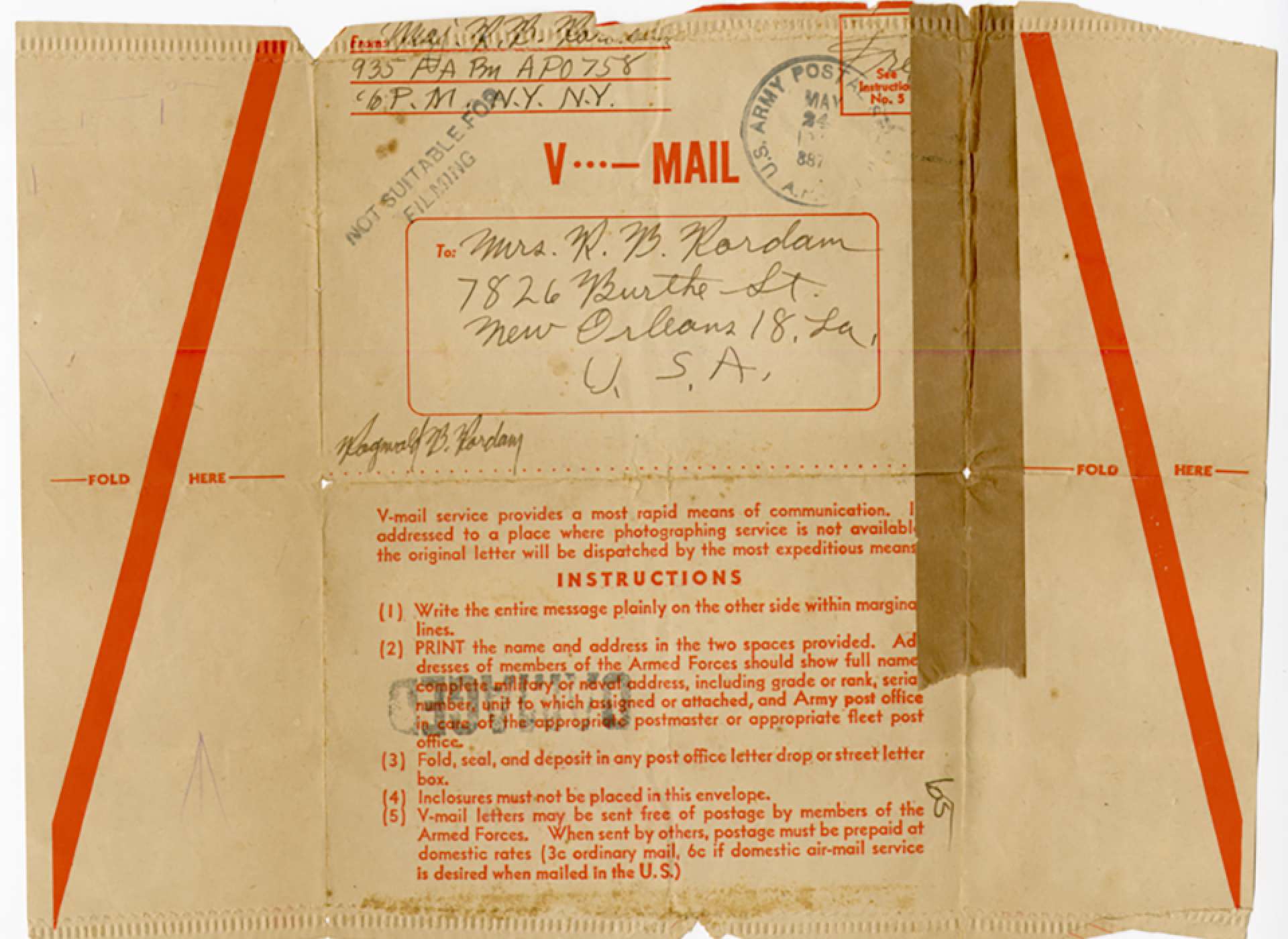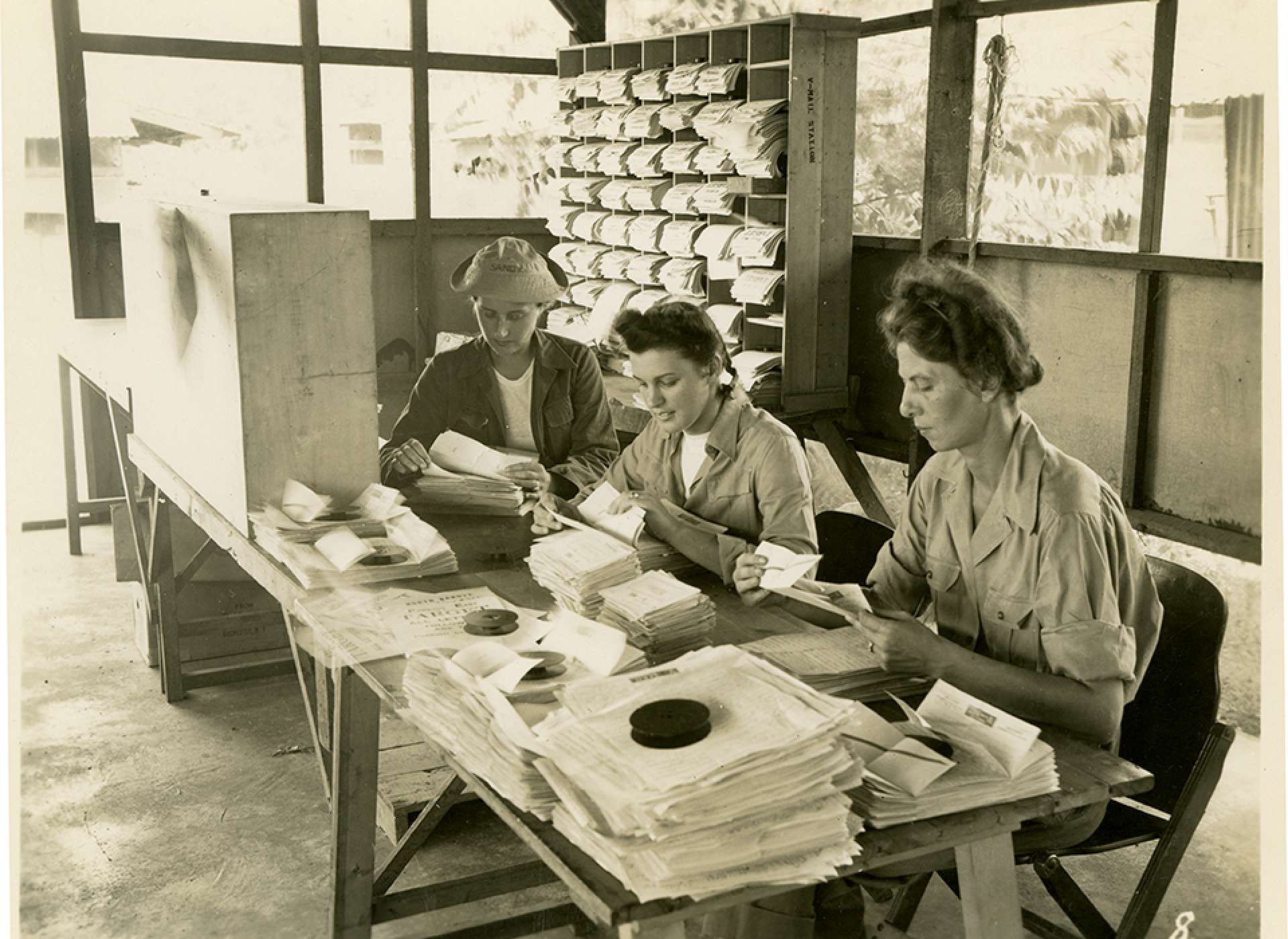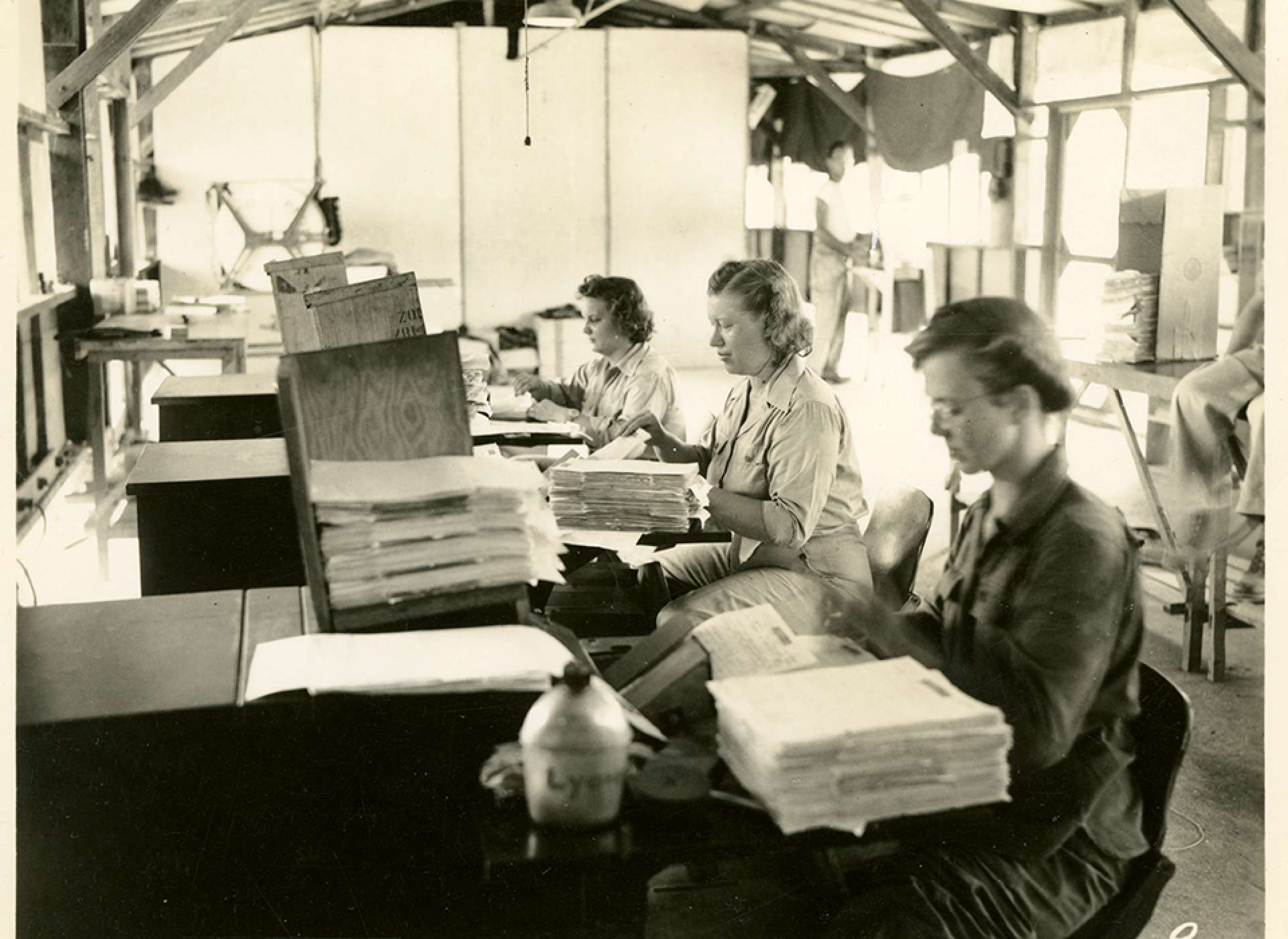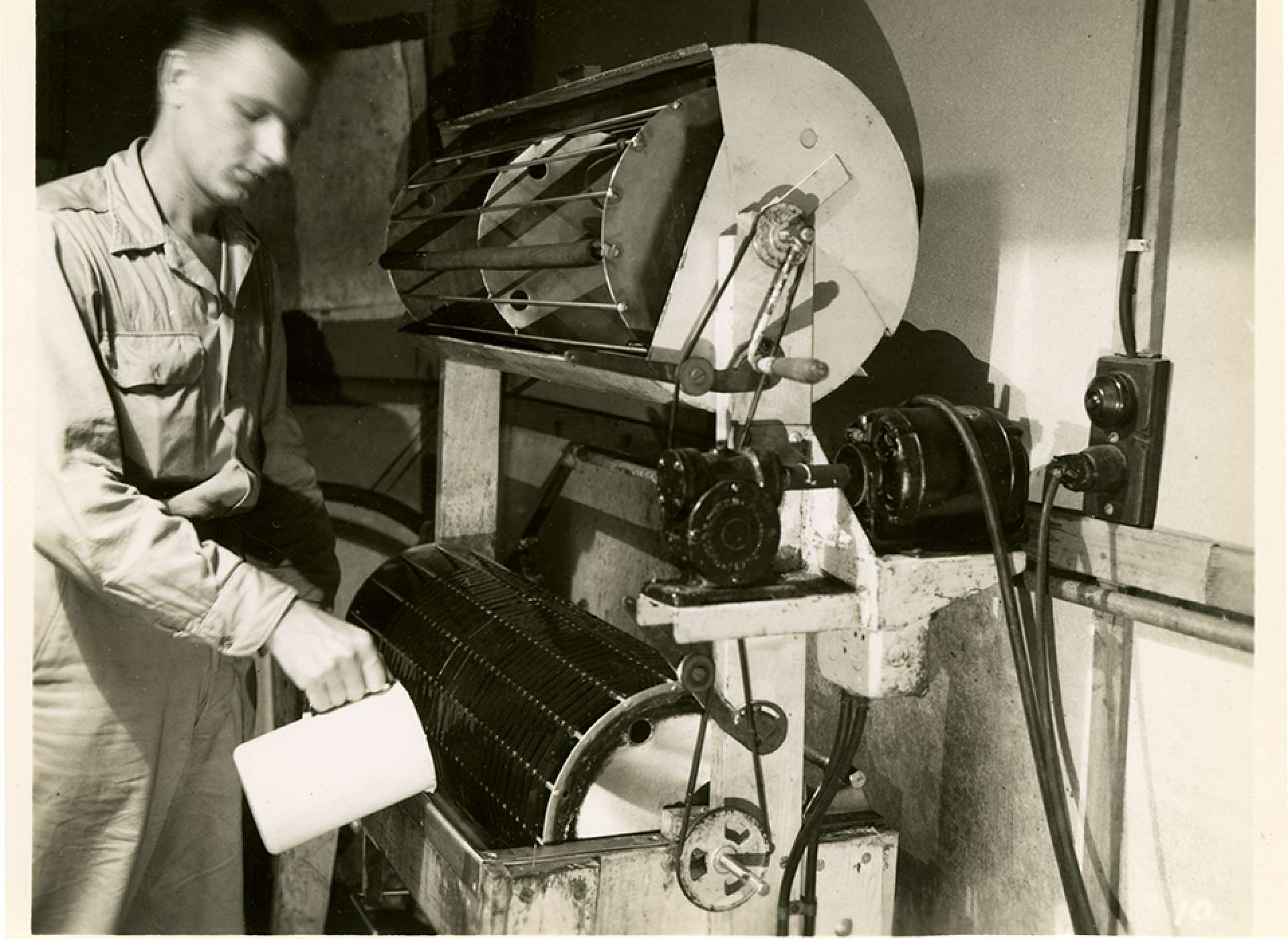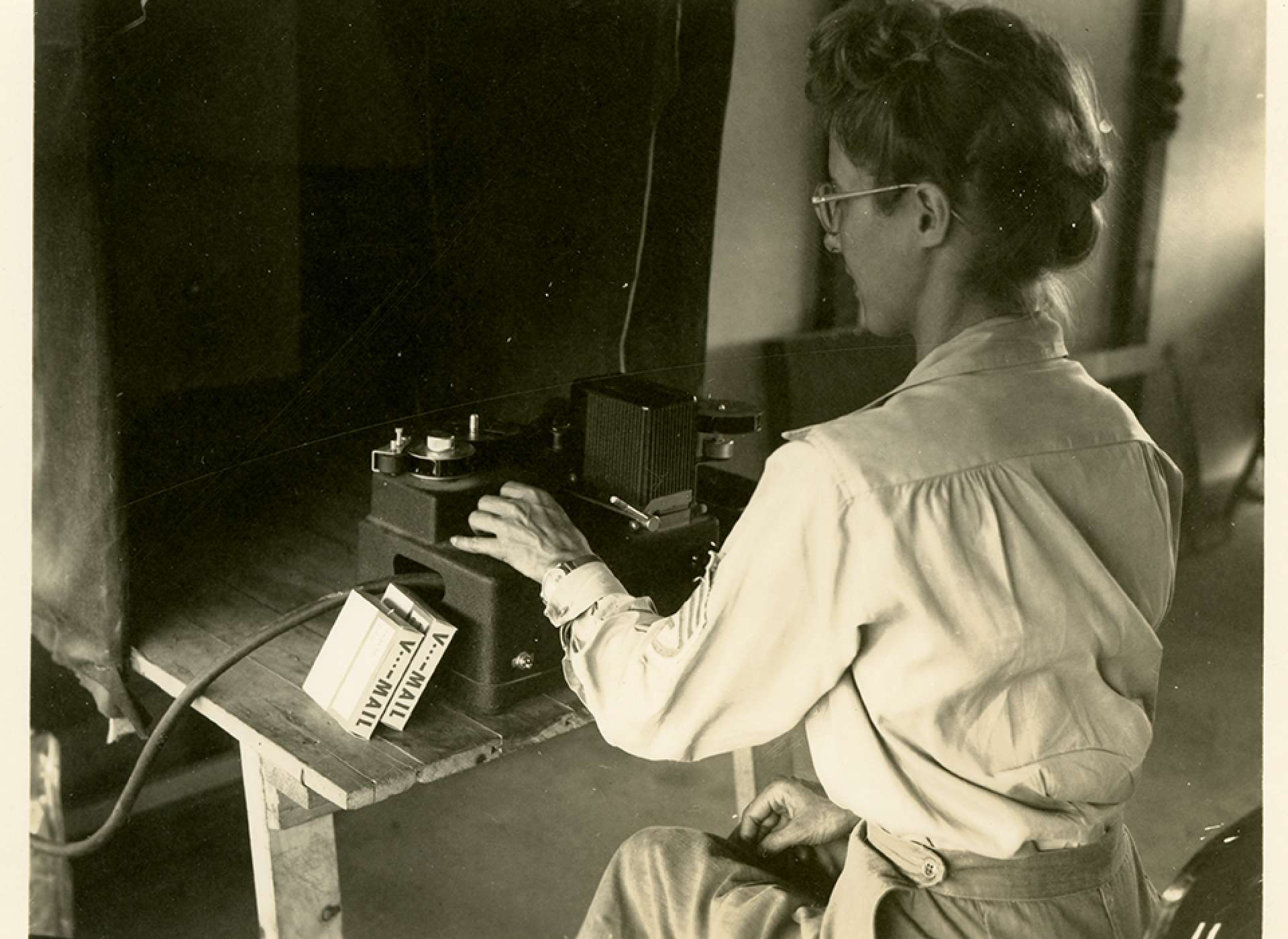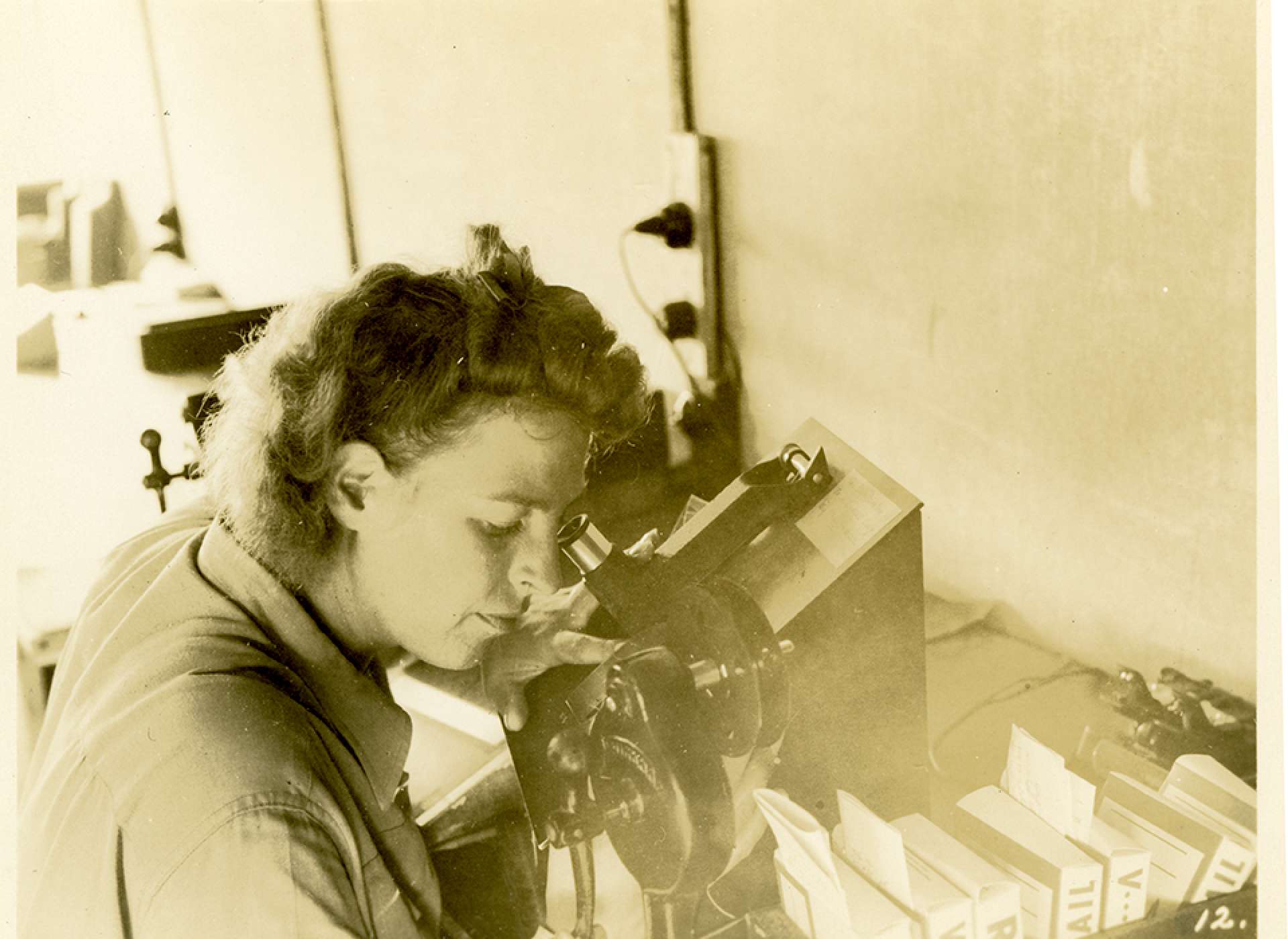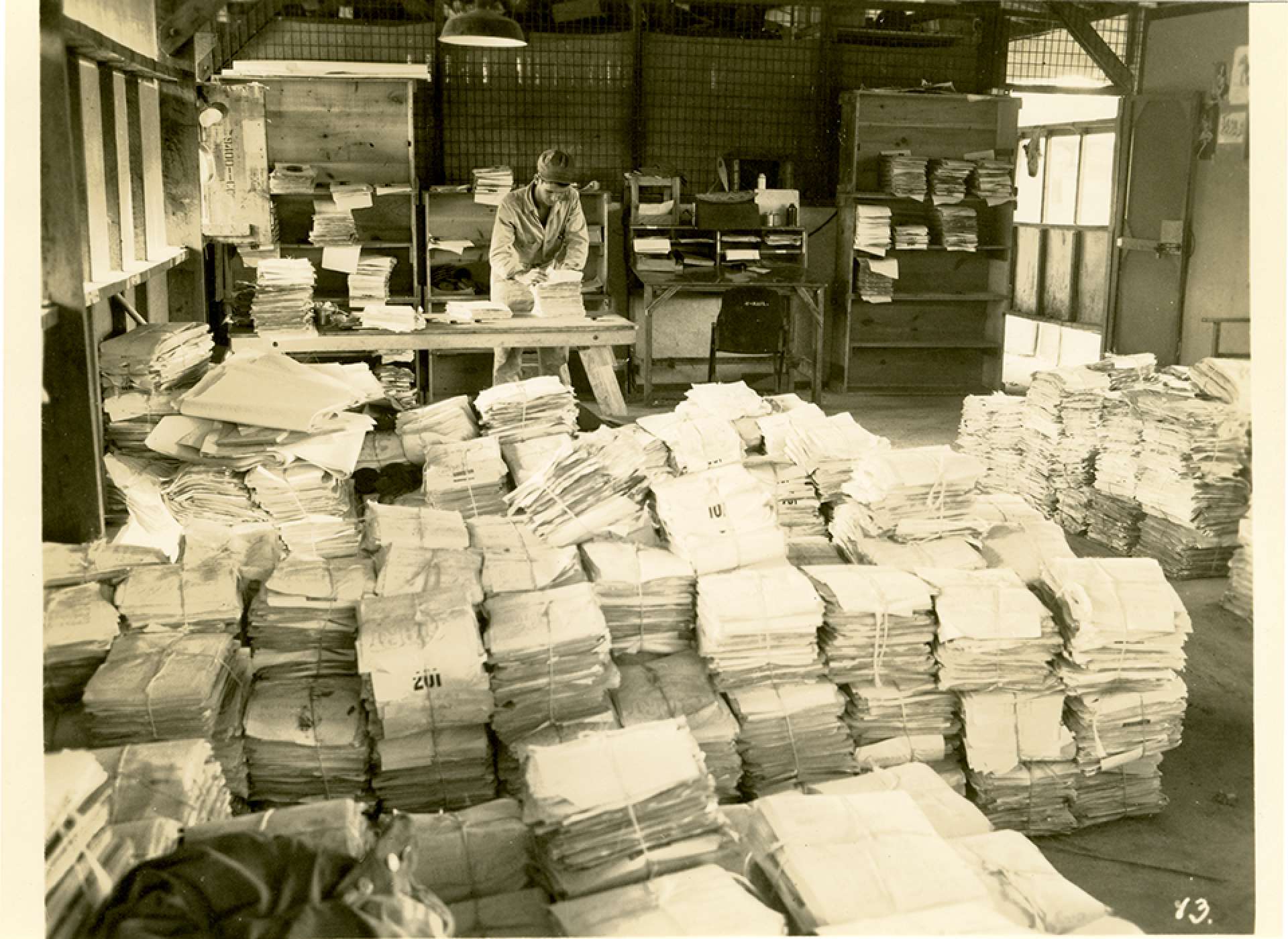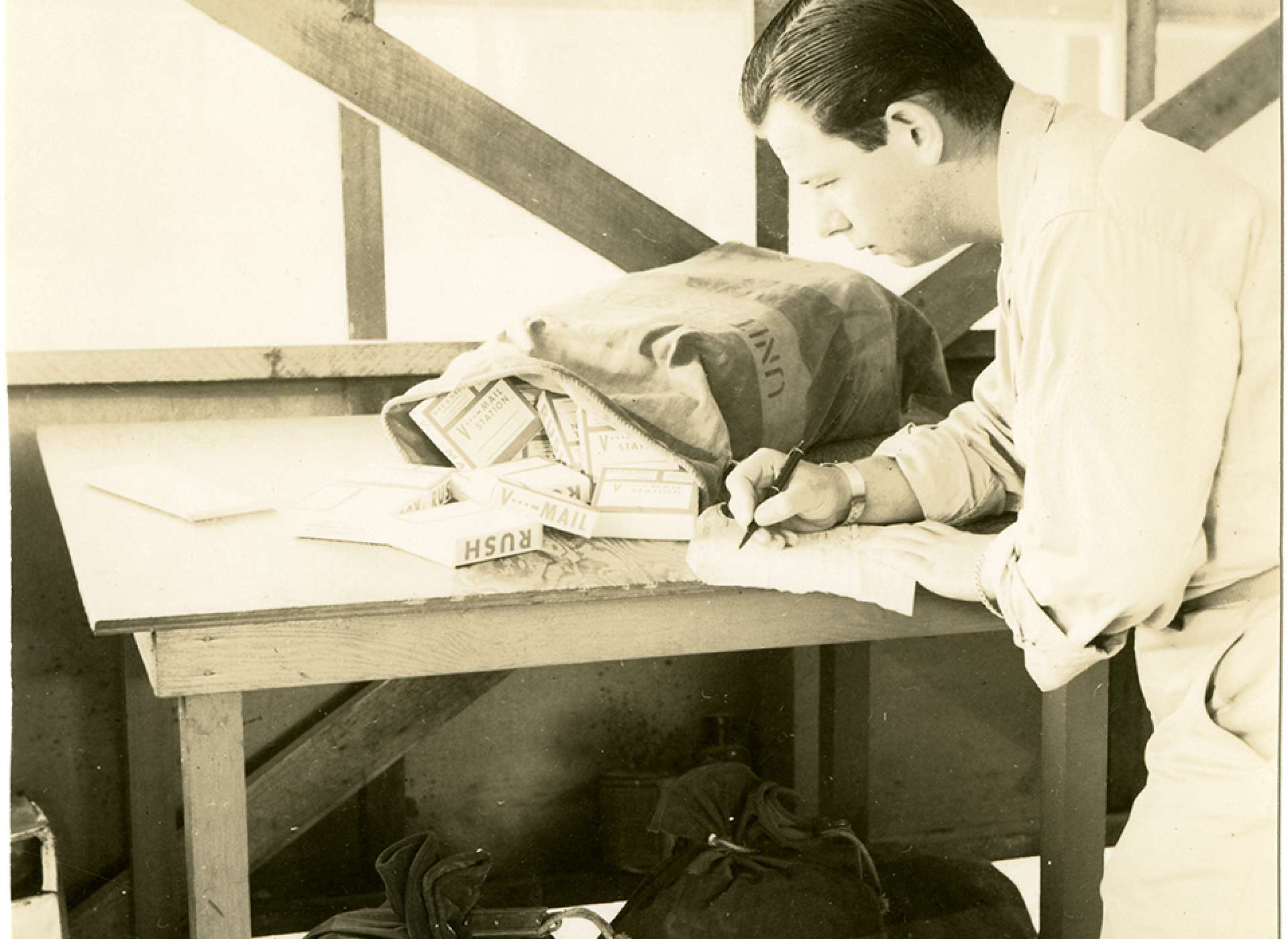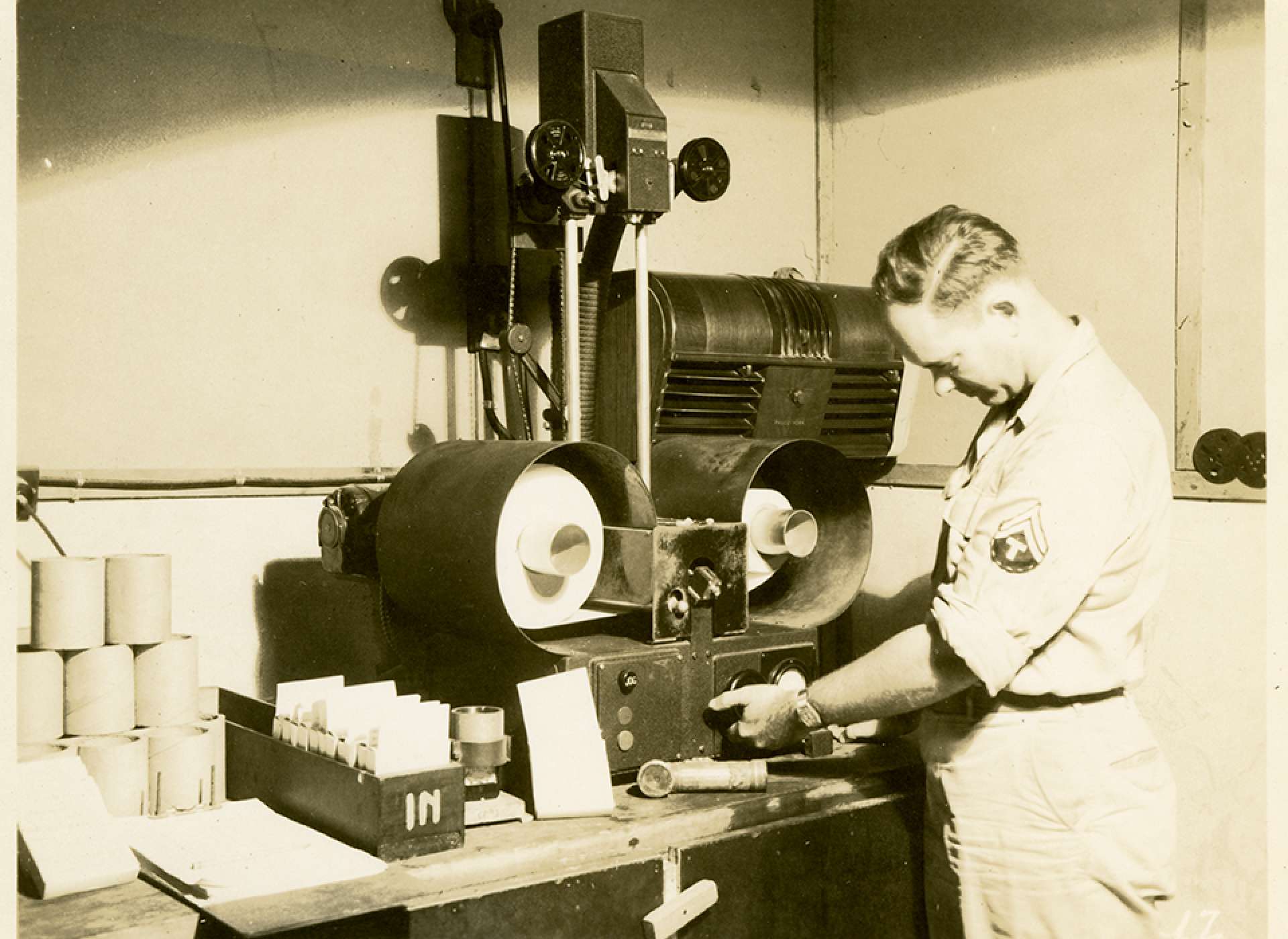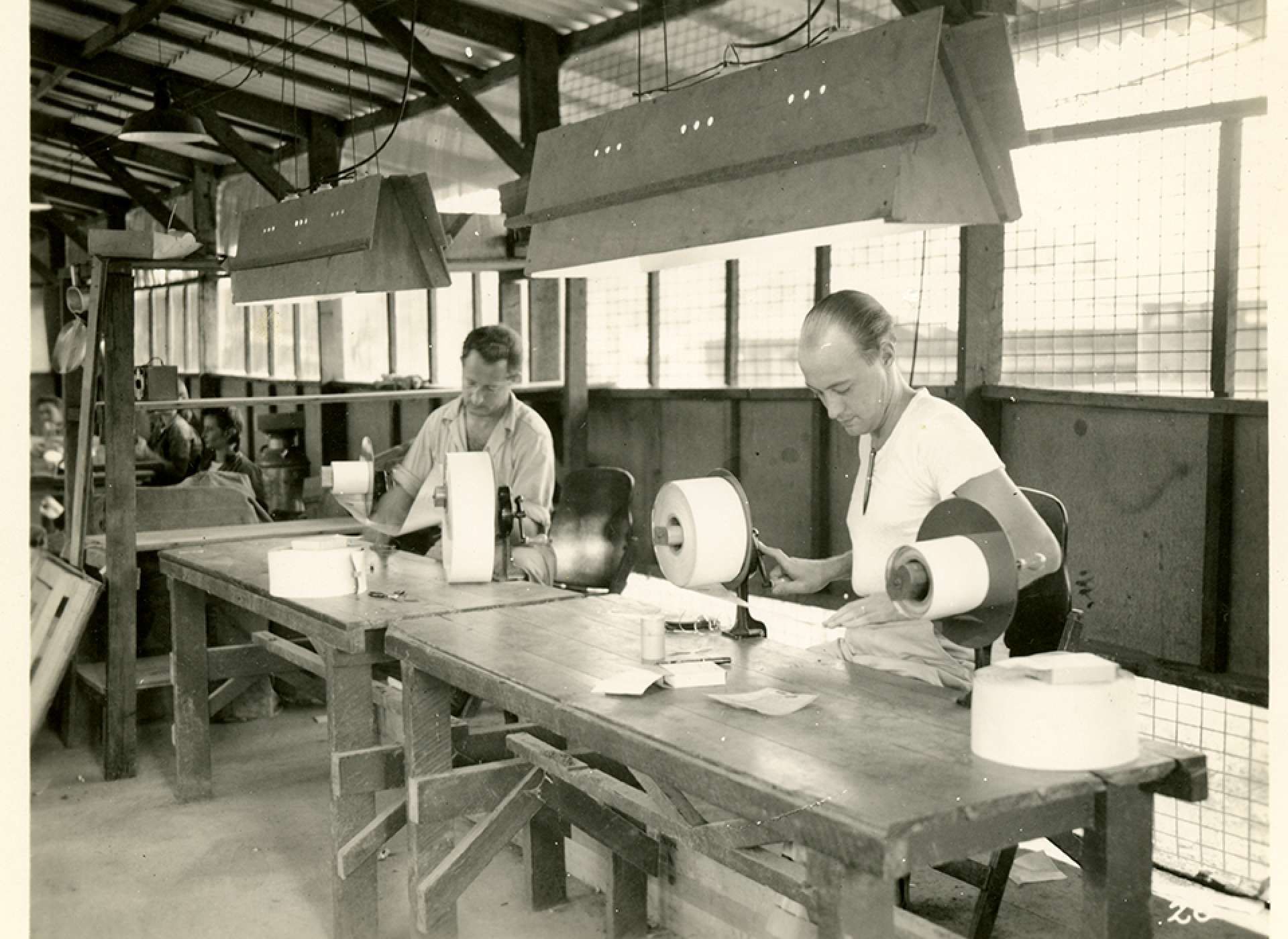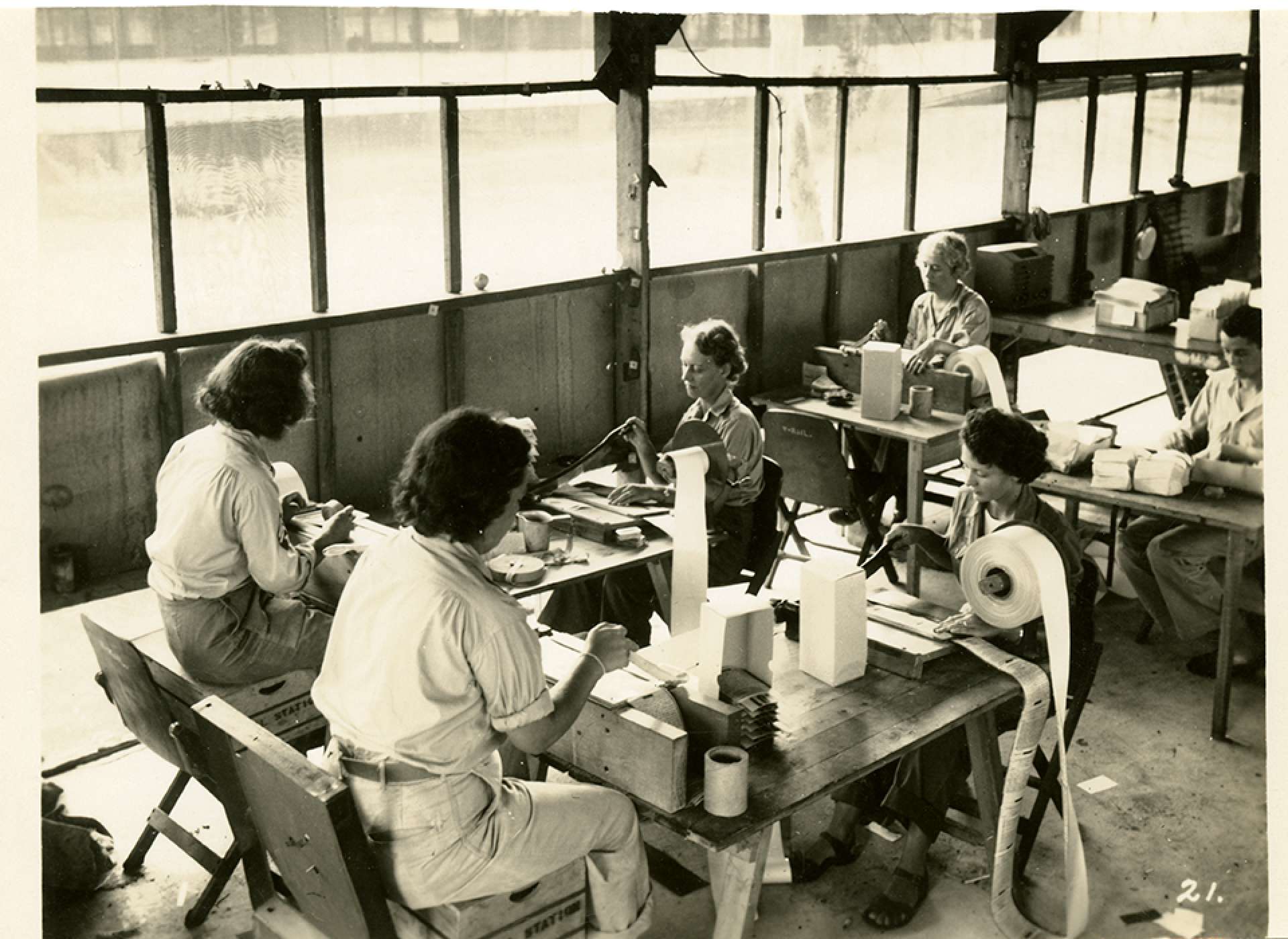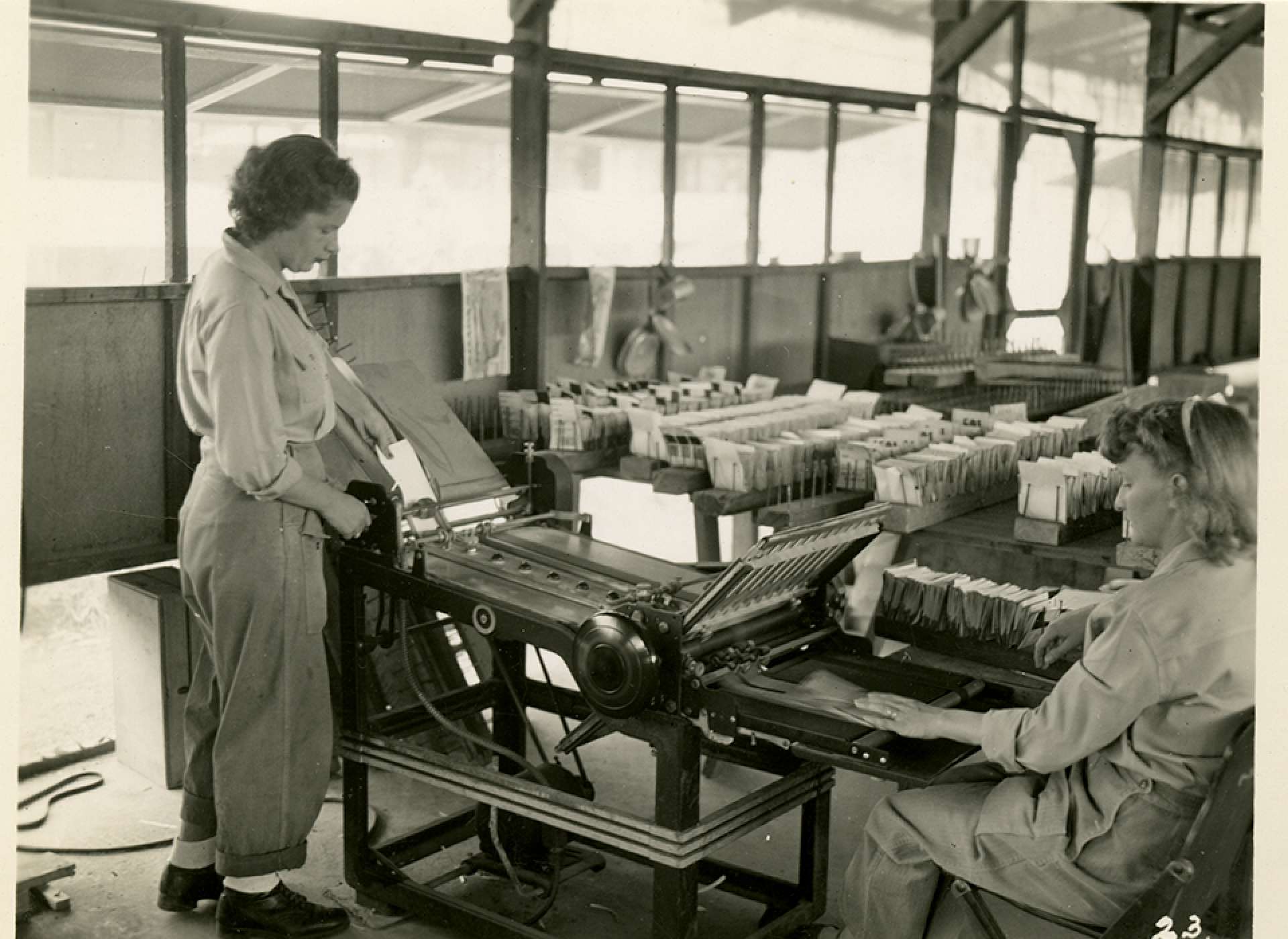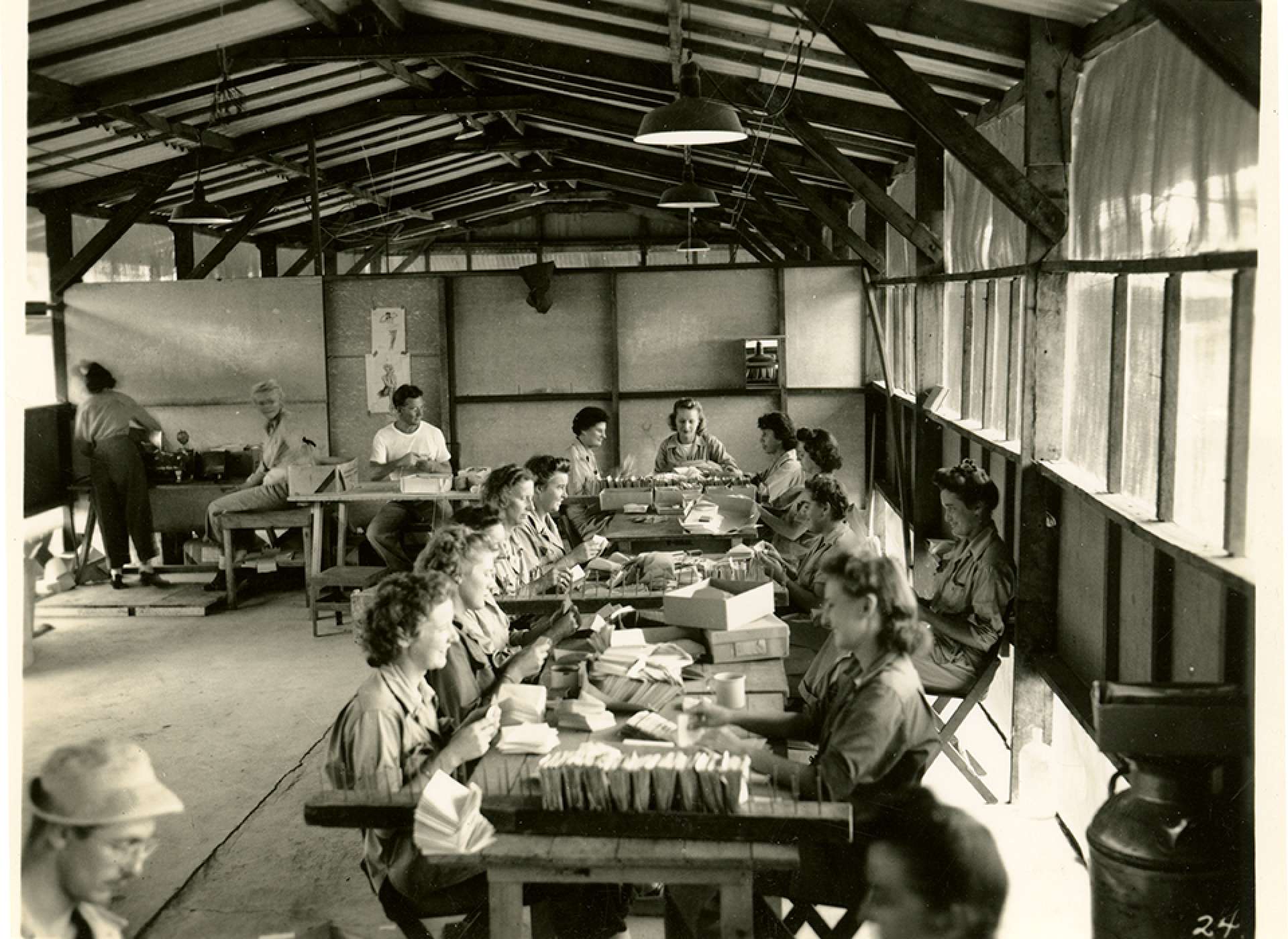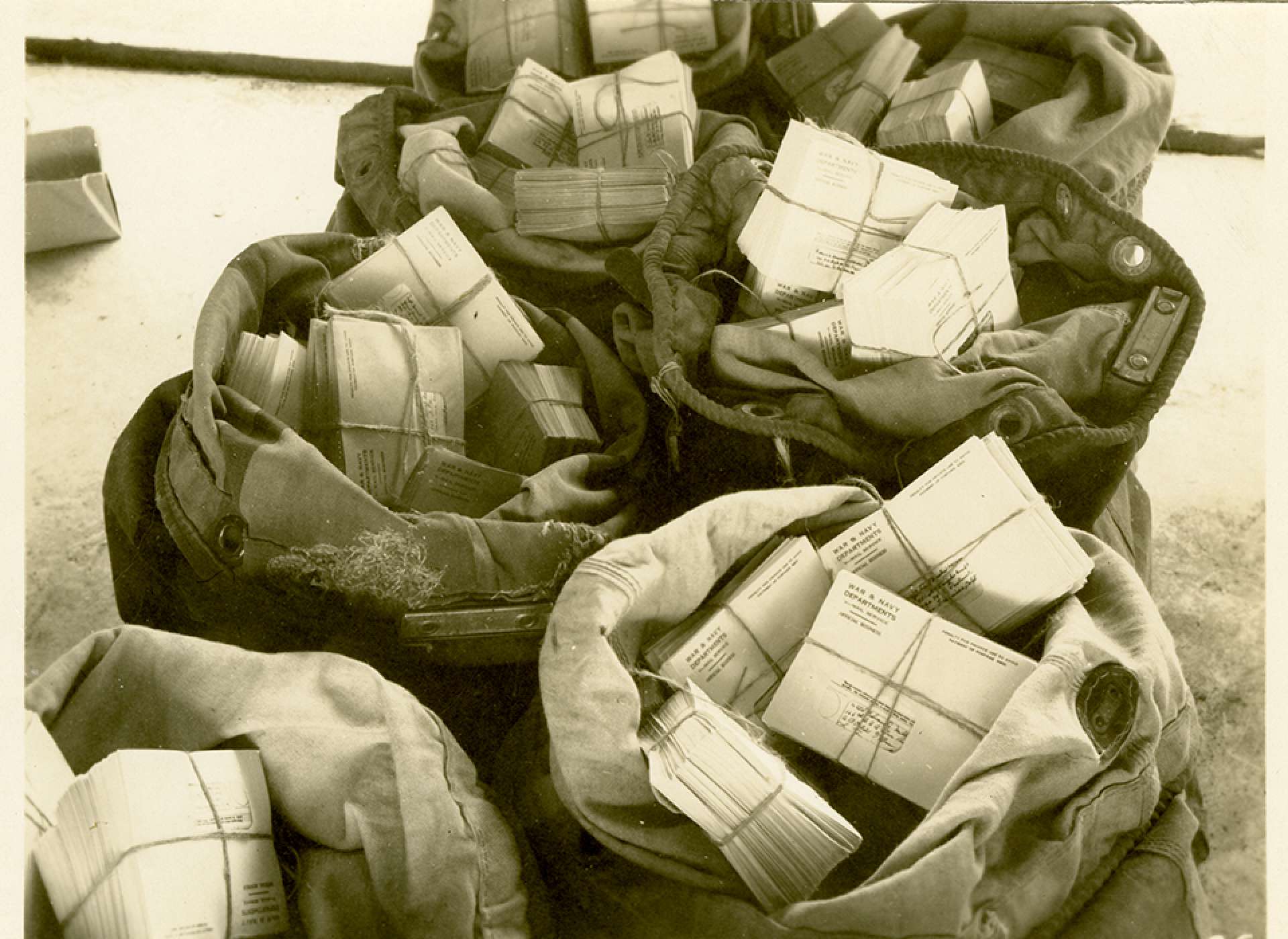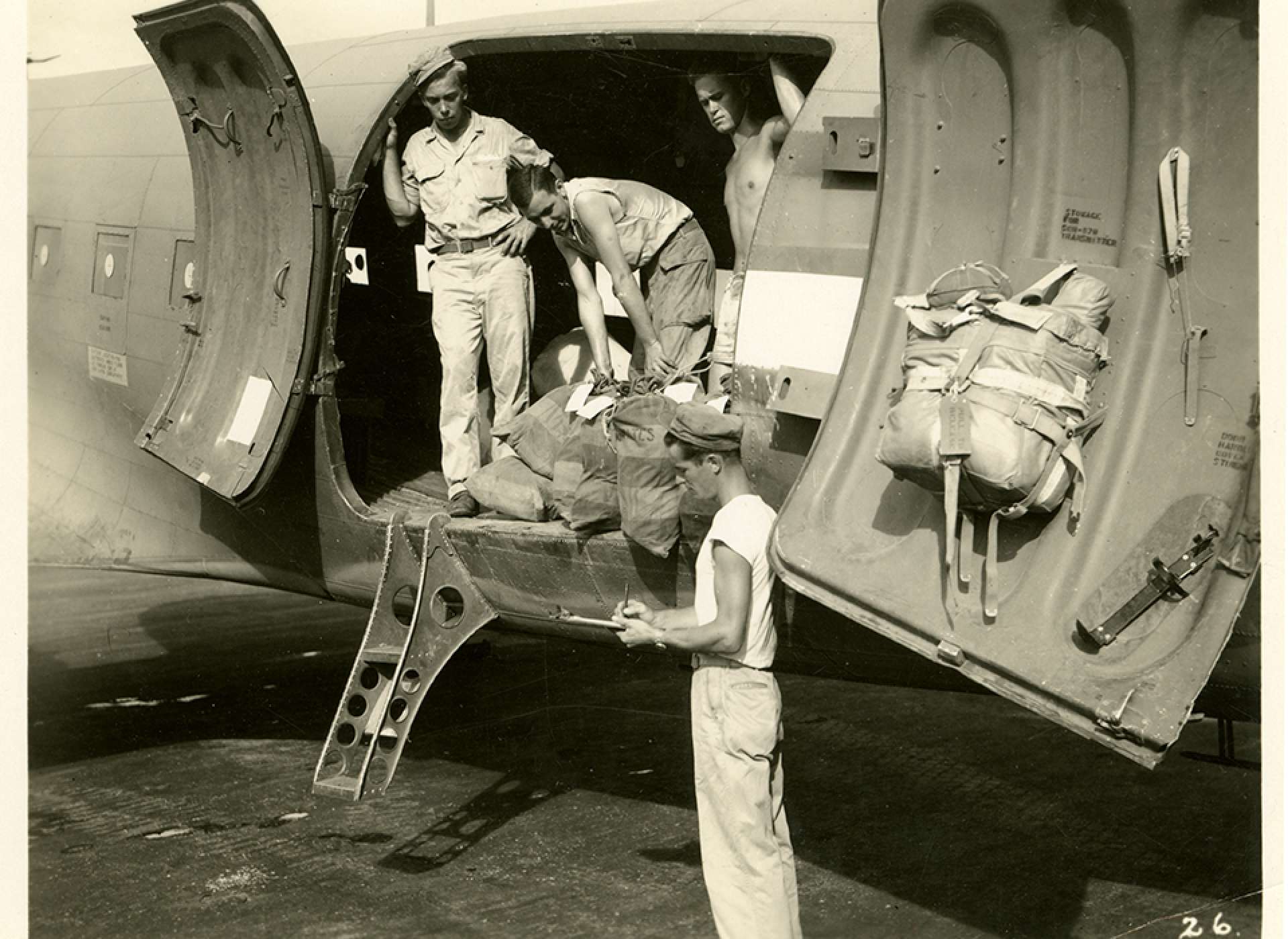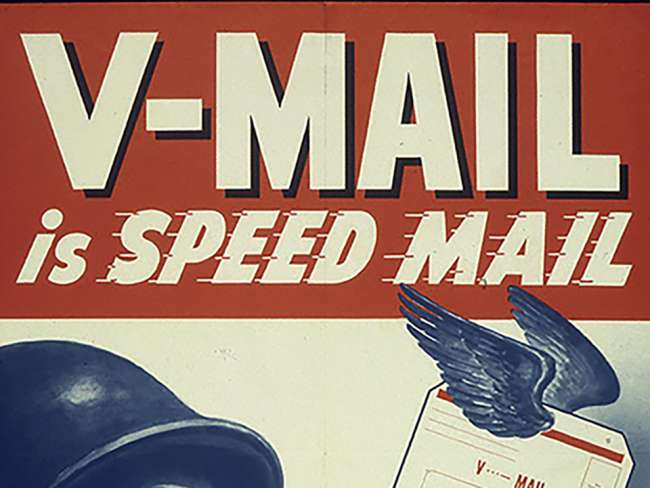The war was the impetus behind a great number of inventions, some of them brand new and some wartime alterations made to existing practice. Many of these developments would continue to endure and evolve, while others remain particular to the period, employed during World War II only, as a way to address a specific wartime need. One specific wartime demand was the efficient and expeditious delivery of mail to US forces serving around the country and overseas.
The critical nature of the mail effort was addressed in the 1942 Annual Report to the Postmaster General which stated: “The Post Office, War and Navy departments realize fully that frequent and rapid communication with parents, associates and other loved ones strengthens fortitude, enlivens patriotism, makes loneliness endurable and inspires to even greater devotion the men and women who are carrying on our fight far from home and from friends.”
The military mail system and the amount of post flowing back and forth internationally during the war was massive. An unprecedented amount of mail was moved about during the war with Army post offices, fleet post offices and US post offices flooded with mail. Each year of the war, the number of pieces of mail increased. In 1945, 2.5 billion pieces went through the Army Postal Service and 8 million pieces through Navy post offices. To bring mail service to those serving worldwide, the military postal system required a global network and innovative practice.
V-mail, short for “Victory mail,” was a particular postal system put into place during the war to drastically reduce the space needed to transport mail thus freeing up room for other valuable supplies. Although the V-mail system was only used between June 1942 and November 1945, over 1 billion items were processed through these means. Officially entitled the “Army Micro Photographic Mail Service,” War Department Pamphlet No. 21-1 describes V-mail as “an expeditious mail program which provides for quick mail service to and from soldiers overseas. A special form is used which permits the letter to be photographed in microfilm. The small film is transported and then reproduced and delivered. Use of V-mail is urged because it greatly furthers the war effort by saving shipping and airplane space.”
-

Common pre-printed holiday V-mail. Gift in Memory of William J. Mueller, 2001.490.003
-

Commercially-available packet of V-mail stationary. Gift of Frank Arian, MD, 2009.451.068
-

An example of a “long-form” V-mail, sent through as-is, without being photographed and reproduced, a common practice due to damage or to lack of V-mail facilities. Gift of Ms. Marjorie Walz, 2011.296.005
-

V-mail from Bill Stover to his family commenting on V-mail’s reputation as a speedy service. Gift of the Family of William A. Stover, 2012.314.050
-

Heavily damaged, thus un-processed V-mail. Gift in Memory of Col. R.B. Rordam
The increased demand on the mail service was new, but the technology employed to meet that demand was not. Microphotography had been used since the 1850s, primarily for business and banking. To keep track of checks and money, a machine called the “Checkograph” was developed. In 1928, Kodak debuted the “Recordak I” as a way to film documents, and in 1935, Kodak began filming and then publishing the New York Times on microfilm.
By the beginning of the war, American postal planners also had their eyes on Britain. Aerograph Ltd. was Britain’s use of microphotography of mail, implemented in 1941 when the first Aerograph letter was sent by Queen Elizabeth. The United States studied the British model and developed the V-mail system. In May 1942, the United States entered into a contract with Kodak for V-mail microfilming. On June 12, 1942, President Franklin D. Roosevelt received the first two V-mails. Then on June 1, 1942, V-mail service began.
An important part of the V-mail system was the use of a standardized stationery which combined the letter and envelope into one piece of paper. Even without microfilming, this was a great space-saving measure. The form was a sheet specially designed by the Government Printing Office and was provided free of charge by the Post Office at the rate of two sheets per person per day. Consumers could also purchase sheets made by different sanctioned providers. All of the paper used for V-mail had to be the same size and weight so that the pages could be fed into the processing machine for microfilming. The way one wrote on the letter also played a big part in whether one would ultimately be able to read the reduced version. Users of V-mail were instructed: “Use typewriter, dark ink, or dark pencil. Faint or small writing is not suitable for photographing.” The original forms could accommodate up to 700 typed words. Despite instruction, there was still some confusion about the use of V-mail.
The Post office, the War, and Navy Departments worked together in the complicated V-mail operation. There were three giant postal centers in New York, San Francisco, and Chicago. All of the mail was funneled through these centers. Kodak trained filmers to work with the Recordak machines. The military was then responsible for transporting the reels overseas. The V-mail station overseas would print and distribute. Some centers had machines that would open and flatten the letters before filming, but most were prepared by hand. Censors would also read each letter before they were filmed. Because they were going to be filmed, the letters had to be blacked out rather than cut out should they contain any sensitive material.
The Recordak could film 40 letters per minute and 1600 letters were accommodated per roll. The clerks assigned numbers to each V-mail, which corresponded to reel numbers. Each sender station kept the original copies as backups until they were notified by the receiving station that the reel had been properly transmitted. At the receiver station, clerks reproduced each frame onto photographic paper. Because of this there was the claim that no V-mail was ever lost. This was a selling point in the use of V-mail. It was supposed to be a more secure mail system. All V-mail was sent air mail, so it was also quicker. V-mail was also free of charge for all servicemen.
Series of photographs with original captions from the service of WAC (Women’s Army Corps) Corporal Mary T. Lynes who served at APO 929 in New Guinea. Gift of John M. Lynes Sr., 2010.309
-

V-mail operation in the field at APO 929. “Here is a section of the opening and targeting operation. Targeting is simply preparing each group of letters with a State target so mail for each group of States can be sent to its proper finishing station in the States. Here also, are withdrawn all letters which will not photograph well. These, of necessity, must be sent by regular mail, which in this case means by air.” Port Moresby, Papua New Guinea. 1944
-

V-mail operation in the field at APO 929.”The recording operation, using the Recordak machines. These operators photograph approximately seventeen hundred letters on each 100 foot roll of film, and can be done in about three quarters of an hour.” Port Moresby, Papua New Guinea. 1944
-

V-mail operation in the field at APO 929.”The next step is the processing of the film, which is done both on automatic machines which do individual rolls. In this shot the operator has completed the developing and is pouring in the hypo or fixing bath, after which the film will be subjected to a water spray to wash it thoroughly. It is then fed on to the upper reel which it is thoroughly dried by means of a warm air stream.”
-

V-mail operation in the field at APO 929.”After processing the film is taken to inspection where it is carefully examined on a projection machine, for any flaws which may have occurred either during the recording or in developing. These bad letters are then punched out and tallied, so they can be re-photographed on a later roll.”
-

V-mail operation in the field at APO 929.”Following this, the density of the film is measured on a densitometer and the density noted on its carton, just prior to dispatch.”
-

V-mail operation in the field at APO 929.”The retake department where all originals of V-Mail are stored until destruction orders are issued by the States. Destruction orders are not issued until the States stations have satisfactorily reproduced every letter on a roll. Should the States advise that certain letters must be rephotographed, the proper bundle must be located and the letter withdrawn to be recorded again.
-

V-mail operation in the field at APO 929. “Initial step in the Receiving section is this operation of checking the postal dispatch sheets and logging in the rolls received from the States. This section is now receiving and completely processing an average of seventy rolls per day.” Port Moresby, Papua New Guinea. 1944
-

V-mail operation in the field at APO 929.”View of the continuous enlarger on which the image on the film is enlarged to regular V-Mail size of 4¼ x 5 inches. Sensitized rolls of paper, 825 feet in length are used. Here, the operator is adjusting the voltage to secure proper exposure. This is determined by consulting a chart which suggests certain voltage and lens aperture settings for any given film density.”
-

V-mail operation in the field at APO 929. “Paper inspection. At these tables each roll of finished work is inspected letter by letter and all badly reproduced letters are marked out. Where possible, an attempt is made to produce a better print in the Reprint department. Letters which cannot be satisfactorily reproduced are either sent back to the States to be rephotographed or to be sent via regular mail.” Port Moresby, Papua New Guinea. 1944
-

V-mail operation in the field at APO 929. “Paper chopping. At these choppers each letter is handcut from the roll and here the culls or bad letters are pulled out. Approximately twenty minutes is required to completely chop a full roll of V-Mail.” Port Moresby, Papua New Guinea. 1944
-

V-mail operation in the field at APO 929. “On this machine the letters are folded to correct size for insertion into V-Mail envelops, an operation which requires about eight minutes per roll. In the background are racks of folded letters.”
-

V-mail operation in the field at APO 929.”This is a view of the inserting and sealing. At the long table the girls must hand-insert each letter, after which all the envelopes are fed through a sealing machine. In the rear, the sealed letters are then bundled and bagged for dispatch to the Post Office.”
-

V-mail operation in the field at APO 929.”Finished V-Mail bundled, bagged and ready for dispatch through the APO to the troops.” Port Moresby, Papua New Guinea. 1944
-

V-mail operation in the field at APO 929.”The final act at the airstrip with the mail truck, containing letters for the States and for the troops, pulled alongside the plane.” Port Moresby, Papua New Guinea. 1944
Was V-mail a success? It took a while to catch on and there is evidence that V mail was seen as less than a “real” letter. In February 1943, one correspondent, Ida “Dee” Ehlers wrote to her husband Lt. Harry Ehlers “I have not written you many letters lately. Have sent V Letters instead because they say (the papers) that only V Letters are sure to be delivered.”
V-Mail had its drawbacks. It was somewhat limiting in that only certain number of words could be used. Since the photo prints were ¼ size of the original letter, if the print was too small then the final product was unreadable.Some stores actually sold special “V-mail readers,” magnifying glasses so that readers could decipher the reduced print. Another downside of V-mail is that one also couldn’t send enclosures (at least initially) and could not leave a personal imprint in the form of a lipstick kiss on the paper. Lipstick was referred to as the “scarlet scourge,” because it would gum up the machines used to film the letters. Any dirty, damaged or crumpled letters had to be sent through as is without microfilming. Anyone who has ever dealt with a paper jam, knows how sensitive automatic feed equipment can be. Some letters whether because of condition or because of the lack of time or equipment to process, were sent through un-filmed, or in their original unprocessed format, instead of the photo print.
But despite its faults, V-mail was aided by marketing which branded the use of V-mail as a patriotic duty and use of the service picked up over the years. There is no denying that the V-mail practice saved vital shipping space. Space saving were great: 37 mail bags could fit within 1 mail bag of V-mail and around 1600 letters could fit on a single 100-foot roll of 16mm film. It also most certainly an initiative tied specifically to World War II, having only been produced between June 1942 and November 1945. The Museum’s collection contains several thousand V-mails, which pose the same challenge to Museum catalogers’ eyes as they did to the recipients’ 75 years ago.
Kim Guise
Kimberly Guise holds a BA in German and Judaic Studies from the University of Massachusetts Amherst. She also studied at the Universität Freiburg in Germany and holds a masters in Library and Information Science (MLIS) from Louisiana State University. Kim is fluent in German, reads Yiddish, and specializes in the American prisoner-of-war experience in World War II.
Cite this article:
MLA Citation:
APA Citation:
Chicago Style Citation:
